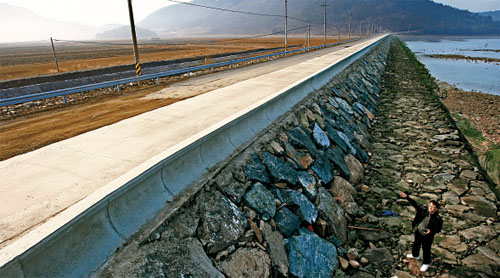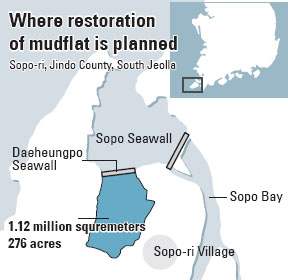From tidelands to rice paddies and back again

Villagers want to remove the Daeheungpo Seawall, left. By Oh Jong-chan
While the land reclamation project has been a success, a project to demolish the seawall is under way. This would be the first such restoration in Korea, though similar projects have been done in countries like Germany, Britain and the Netherlands.
“Among the 80 areas recommended by specialists and local governments for tideland restoration, we have been doing feasibility studies and we will select three places for pilot projects,” said Yun Hyun-soo, maritime and ecology director at the Ministry of Land, Transport and Maritime Affairs. “Sopo-ri, Jindo County will be included in the three.”
The other two places are unused farms. The ministry, Jindo County and the National Nature Trust had a workshop in Sopo-ri Saturday to discuss project details.

The restoration project started in 2006 when Kim was village headman. Most of the 340 residents support the idea.
There have been other changes in how people view tidelands. During the controversy over the Saemangeum reclamation in North Jeolla, experts argued that mudflats are more productive than farmland, considering fishery products, pollution reduction and the species of animals that make their homes there.
Rice consumption is also declining in Korea and the total area used for rice paddies is getting smaller. There is less need to reclaim mudflats. People in rural areas are also aging.
Outside Korea, there have been numerous tideland restorations in efforts to revive seashore ecology.
According to Kang Ho-jeong, a professor at Yonsei University, tideland plants grow faster and absorb more carbon dioxide, which causes global warming, than other plants.
Jindo County also supports the restoration. “We will spend 100 million won ($72,358) on the feasibility study this year and form a committee of specialists and residents,” said Park Hye-gyeong, a county employee. The National Natural Heritage Trust will sign a memorandum of understanding with Jindo County on March 24 to start the restoration in full.
When Sopo-ri is selected for the pilot project, the ministry and Jindo County intend to purchase 70 to 80 percent of the farmland slated to be returned to the sea. “It’ll take six to seven years for the farmland to become mudflats again,” said Chung Seung-soo, a professor at Chonnam National University.
For the project to go smoothly, there needs to be some agreement on how to raise funds to build an ecology park, how much will be paid to purchase land and how residents will make a living during the restoration. Tidelands in South Korea cover 2,550 square kilometers, or 42 percent of the tidelands that existed in 1960.
A total of 810.5 kilometers of tidelands was reclaimed between 1987 and 1998. In the last 10 years, projects to reclaim over 100 kilometers of land have been under way.
By Kang Chan-su JoongAng Ilbo [jbiz91@joongang.co.kr]










with the Korea JoongAng Daily
To write comments, please log in to one of the accounts.
Standards Board Policy (0/250자)